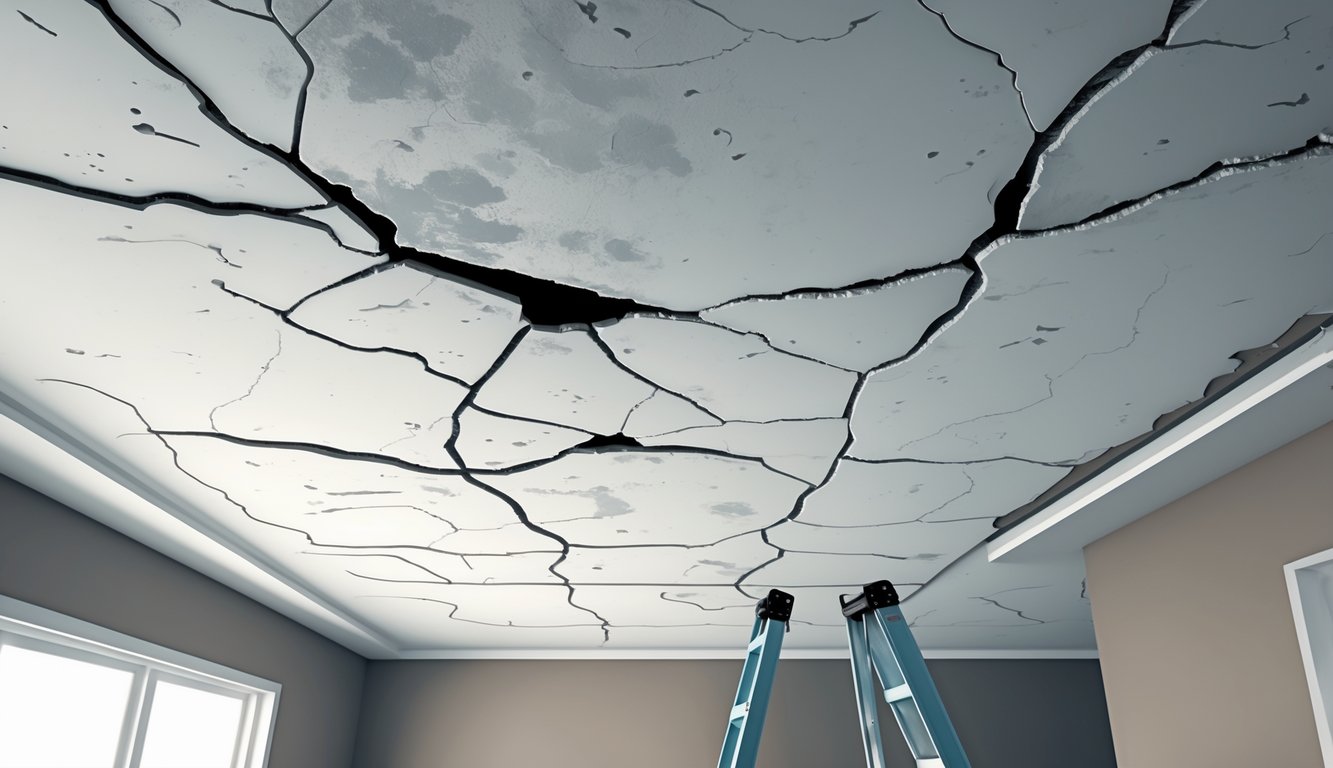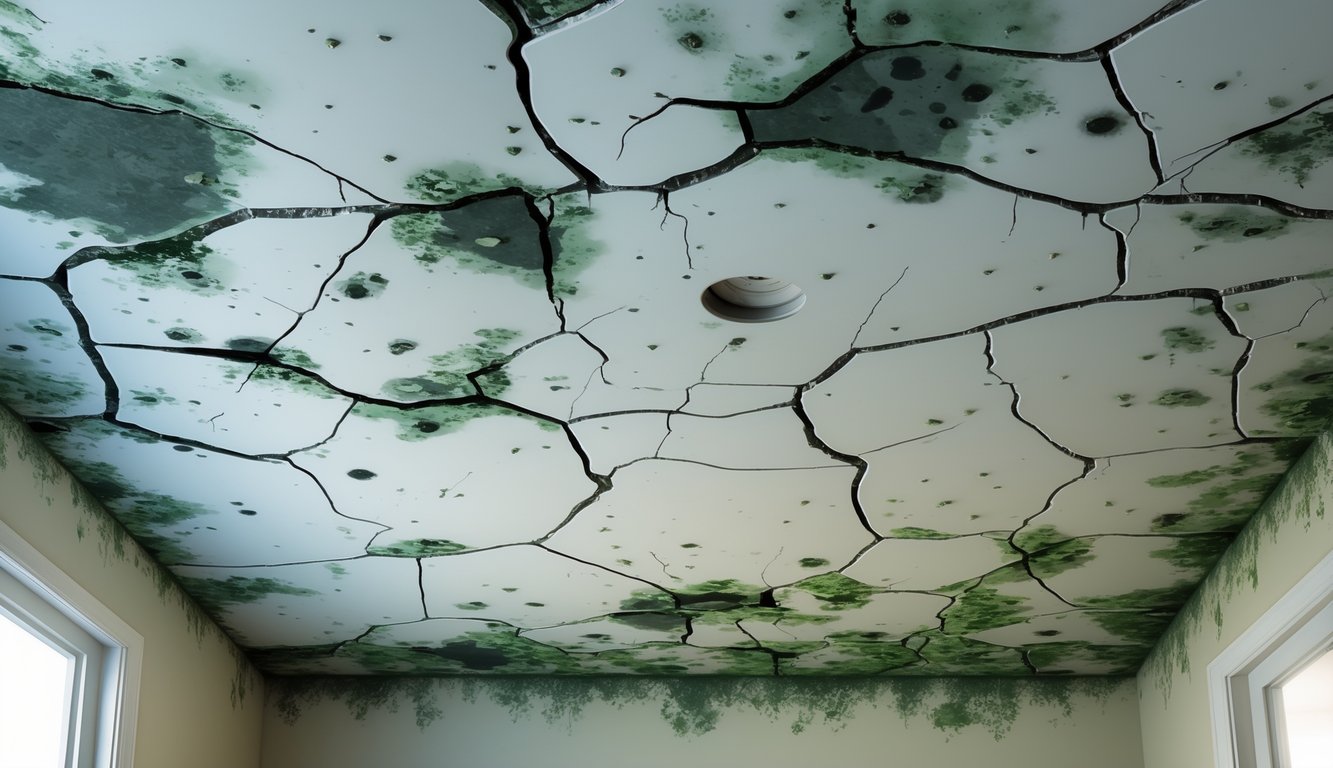
Structural Damage: When Cracks Spell Trouble
Seen way too many people ignore ceiling cracks until it’s not just a patch job but a full-on structural nightmare. Why do we all wait until it’s a crisis? Hairline cracks wandering around light fixtures, doorways, or across a room—your bank account will hate you if you just let it go.
Foundation Problems and Home Stability
Why is it always the tiniest cracks that turn into monsters? Had one above the living room doorway—doubled after heavy rain. My home inspector friend muttered about foundation problems, but I just figured old houses do this. Wrong. Turns out, foundation settling warps beams and joists, so cracks widen every month.
Engineers say foundation movement makes ceiling cracks spider out at corners and across the middle. Watch for crooked crown molding, sticky windows, doors that won’t stay closed—those are big warnings. Diagonal cracks from ceiling to wall? Classic shifting foundation. I started marking the cracks with pencil lines—if they move, I call someone. There’s no magic fix, either. Sometimes it’s epoxy, sometimes you’re digging up the yard. Never simple.
Truss Uplift and Ceiling Separation
Truss uplift. Annoying, and it’s not just a “cold climate” thing. Even saw it in dry Arizona. Attic trusses flex with humidity, and builder-grade tape just laughs and fails. Cracks show up where ceiling meets wall, sometimes straight, sometimes zigzagging down the hall. I had a pro dismiss my seams as “seasonal uplift”—two years later, chunks literally separated after a cold snap.
Supposedly, flexible clips help, but nobody installs them. If the same crack keeps reopening every winter, you’re not alone. Watch for nail pops, tape peeling, or insulation that looks weird up top. That’s classic uplift. Inspection guides say wider cracks and sagging mean you’re past DIY territory. Take monthly photos—insurance adjusters love dated proof. But does the crack ever really go away? I doubt it.
Hidden Dangers: Water Damage and Mold Growth

What drives me nuts is how a tiny ceiling crack—sometimes hiding behind furniture I never move—can mean way more than just “ugly.” Suddenly I’m in the hardware aisle, stressed about stains and wondering if my cough is the air freshener or something nastier.
Mold Risks and Health Concerns
Every faint brown spot overhead makes me think of those hidden dangers of ceiling leaks. Usually, you don’t notice until you’re Googling “musty smell won’t go away” at 2 a.m. Mold doesn’t need much—just a bit of moisture and no sunlight, and now spores are everywhere. Black, green, orange—whatever. Water-damaged ceilings are a health risk, even for people who swear they’re “never sick.”
CDC says mold can cause sinus trouble, eye irritation, even asthma. My friend thought she had allergies—nope, just mold behind the drywall. Bleach sprays and HEPA filters look nice on Instagram, but real remediation is the only thing that works if mold’s behind the wall. I wish there was a shortcut.
Spotting Signs of Moisture Damage
Peeling paint, saggy spots, weird yellow stains above my closet—none of these ever end with me saving money. Best thing I ever learned: catch ceiling leaks before I see water dripping on my charger.
Water travels in the weirdest ways—along beams, wires, whatever. Once traced a leak across the room, just to find the source was nowhere near the stain. If the place smells musty or paint’s bubbling, water’s probably pooling somewhere you can’t see. And nobody told me, but if insulation feels heavy or drywall bows even a little, calling a pro right away is cheaper than waiting. Seriously, keep a $10 moisture meter and check after storms. Ceilings sag or smell off? Don’t wait. Even tiny leaks can turn into thousands in repairs, not to mention mold that lingers forever. Those ugly stains above the light? Could be rot hiding deep in the structure—painting over it won’t help.
Assessing and Diagnosing Ceiling Cracks

Isn’t it always something? Found a spiderweb crack in the hallway last week, and now my anxiety over ceiling cracks is somehow more expensive than my last three freelance gigs. Funny how cracks split people—some say it’s “just settling,” others want to call a structural engineer immediately. Straight, jagged, faint, glaring—never one clear answer.
When to Call a Professional
Oh, sure, everyone’s got an opinion about ceiling cracks—some cousin’s friend’s dad can “just tell” what’s harmless, but, yeah, every contractor I’ve met immediately grabs a flashlight and mutters something about measurements. I get nervous when a crack cuts across both the ceiling and the wall. Maybe that’s overkill, but, come on, “structural movement” is what the pros call it, and I’m not risking it just because some message board said “probably fine.” People say anything over 0.2 mm is bad news—like I’m carrying calipers around. I just squint and hope for the best.
And then there’s those gross yellow stains—moisture marks that won’t clean off, which, of course, means there’s a leak somewhere up there. Super reassuring, especially after shelling out for roof repairs. If the floor above creaks? I start getting paranoid. Ceiling bows or sags? The internet loses its mind and tells me to call a pro ASAP. Here’s a wallet-saving tip: Don’t just trust any handyman who shrugs it off. I ask about insurance, trade credentials, whatever passes for E-E-A-T these days. If they can’t show proof, why am I even paying them?
What to Expect from a Professional Inspection
So, sometimes you finally get a pro over, and they barely look up before saying, “settlement crack, no big deal.” Other times, some engineer rolls in with a trunk full of gadgets—laser levels, moisture meters (which look like barcode scanners, honestly), crawling into the attic, tapping everywhere, mumbling about “joist spans” and referencing the British Gypsum datasheet like I’m living in London (I’m not). It’s a circus.
They’ll poke around for signs of water damage, or botched drywall jobs—my favorite phrase, “insufficient taping and filling at joints.” Not like the hardware store ever mentions that. If the problem’s structural, forget about a simple patch. My inspector once insisted on reinforcing joists because “cosmetic repairs won’t do squat if the load’s off.” They always leave a report, usually with a red-ink diagram and a bill that makes me question all my life choices.